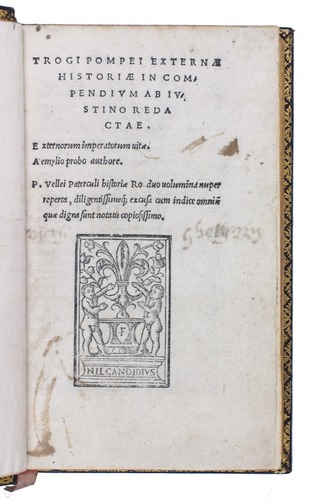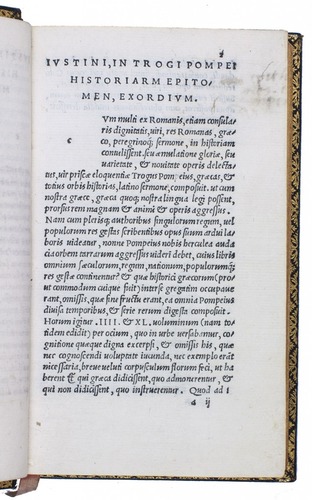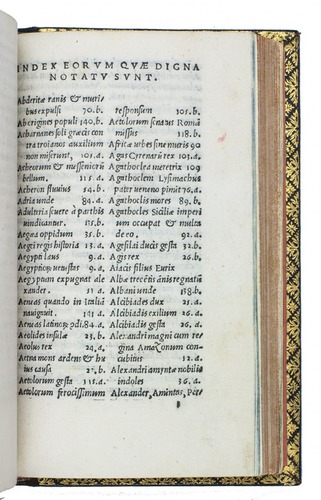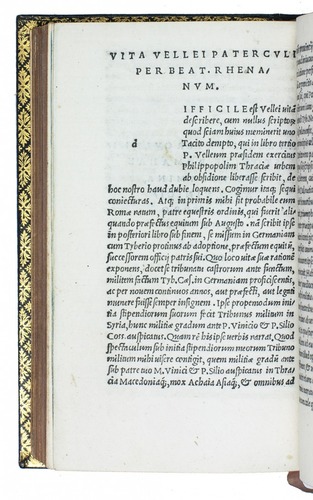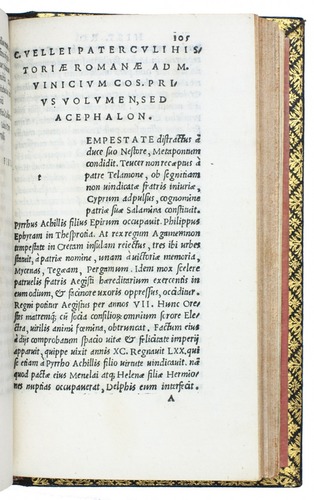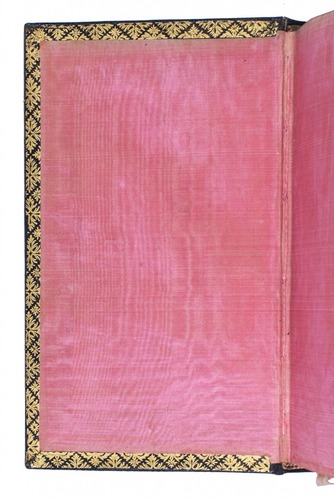JUSTINUS, Marcus Junianus.
Trogi Pompei externae historiae in compendium ab Justino redactae.
Including:
PROBUS, Aemylius [recté NEPOS, Cornelius]. De vita excellentium imperatorum liber.
VELLEIUS PATERCULUS, Caius. Historiae Romanae duo volumina, ...
(Colophon: Florence, Philippo Giunta, 1525). 3 works published as 1. 8vo. With Giunta's woodcut device on the title-page and a nearly identical one on the verso of the otherwise blank last leaf. Set in an Aldine-style italic, with numerous spaces with guide letters where manuscript initials could be filled in (left blank in the present copy). Dark green gold-tooled morocco (ca. 1833?), the with AAR-monogram of Antoine Augustin Renouard, gold-tooled board edges and turn-ins, pink watered-silk endleaves, matching ribbon marker, gilt edges. Attributed to the Bradel family in Paris, probably Antoine Louis François Bradel. 15, [1], “103” [= 203], [1 blank]; [8], “105” [= 205]-267, [1] ll.
€ 5,000
Collected edition containing three works by classical authors. The present edition is based on Aldus's, with corrections. Dibdin notes that the classical philologist Johann Georg Graevius singled out the 1525 Giunta edition for its "considerable authority".
Ad 1: As Justinus notes in his preface, he collected the most important and interesting passages from the Historiae Philippicae by Pompeius Trogus, a massive work originally containing 44 "libri". Since Trogus's work has not survived, Justinus's 3rd[?]-century selections form our best source for the text. Justinus's epitome was extremely popular in the Middle Ages. Trogus originally concentrated on the rise and history of the Macedonian monarchy, but Justinus digressed and elaborated it, adding material on the history of the Roman empire.
Ad 2: Although the title-page and drop-title attribute the Vita to Aemylius Probus, as in all early editions, it was suggested in 1569 that they were actually written by Cornelius Nepos (99-24 BC), the first biographer to be known by name, and also the first to compare Romans with foreigners. Nepos was well acquainted with Cicero, Pomponius Atticus and Catullus. His present biographies, together with those of Cato and Atticus, are all that survives from his writings.
Ad 3: The Historiae of Velleius Paterculus (19 BC-AD 31) is one of the most important documents on the age of Augustus and Tiberius. Part I of the Historiae deals with the history from early times, the Orient and Greece, to the fall of Carthage and Corinth in 146 BC. Part II treats the period 146 BC-AD 30, especially emphasizing the period marked by the death of Caesar (44 BC) and the death of Augustus (AD 14). Velleius's accounts of more recent times, become more and more detailed, focusing on the history of the Roman Empire instead of universal history.
With contemporary marginal manuscript notes, washed out by the binder, but often still readable, and an early owner's name on the title-page. Said to come from the library of Robert Adby (d. 1748), with the "Bibliotheca Heberiana" stamp of the omnivorous collector Richard Heber (1773-1833) and bound for the great bibliographer Antoine Augustin Renouard (1765-1853). Renouard commissioned bindings from Nicolas-Denis Derôme (le jeune) and later his widow and their son-in-law Pierre-Jean Bradel, and it has been suggested that the present binding is by Antoine Louis François Bradel. The preliminary leaves 3-16 have been misbound before the Velleius title-page. With an occasional minor spot or smudge, but otherwise in fine condition. The spine is very slightly faded, but the binding is still generally fine. Adams J725 & P414; Dibdin, Greek and Latin classics II, p. 138 note; Renouard, Annales ... Alde, suppl., p. XLIX, no. 80.
Related Subjects:










